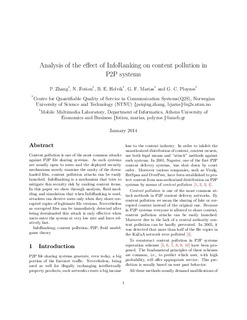| dc.contributor.author | Zhang, Peiqing | |
| dc.contributor.author | Fotiou, Nikos | |
| dc.contributor.author | Helvik, Bjarne Emil | |
| dc.contributor.author | Marias, Giannis F. | |
| dc.contributor.author | Polyzos, George C. | |
| dc.date.accessioned | 2015-01-17T09:30:11Z | |
| dc.date.accessioned | 2015-08-26T08:21:38Z | |
| dc.date.available | 2015-01-17T09:30:11Z | |
| dc.date.available | 2015-08-26T08:21:38Z | |
| dc.date.issued | 2014 | |
| dc.identifier.citation | Security and Communication Networks 2014, 7(4):700-713 | nb_NO |
| dc.identifier.issn | 1939-0114 | |
| dc.identifier.uri | http://hdl.handle.net/11250/297971 | |
| dc.description.abstract | Content pollution is one of the most common attacks against peer-to-peer file-sharing systems. As such, systems are usually open to users, and the deployed security mechanisms merely examine the sanity of the downloaded files—content pollution attacks can be easily launched. InfoRanking is a mechanism that tries to mitigate this security risk by ranking content items. In this paper, we show through analysis, fluid modeling, and simulation that when InfoRanking is used, attackers can deceive users only when they share corrupted copies of legitimate file versions. Nevertheless, as corrupted files can be immediately detected after being downloaded, this attack is only effective when users enter the system at very low rate and leave relatively fast. | nb_NO |
| dc.language.iso | eng | nb_NO |
| dc.publisher | Wiley | nb_NO |
| dc.title | Analysis of the effect of InfoRanking on content pollution in peer-to-peer systems | nb_NO |
| dc.type | Journal article | nb_NO |
| dc.type | Peer reviewed | en_GB |
| dc.date.updated | 2015-01-17T09:30:11Z | |
| dc.source.pagenumber | 700-713 | nb_NO |
| dc.source.volume | 7 | nb_NO |
| dc.source.journal | Security and Communication Networks | nb_NO |
| dc.source.issue | 4 | nb_NO |
| dc.identifier.doi | 10.1002/sec.773 | |
| dc.identifier.cristin | 1080825 | |
| dc.description.localcode | Copyright © 2013 John Wiley & Sons, Ltd. This is the authors' accepted and refereed manuscript to the article. | nb_NO |
